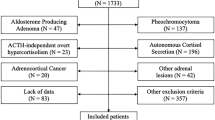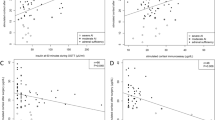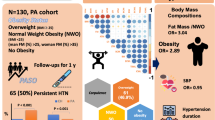Abstract
Background
Obesity-associated activation of sympathetic nervous outflow is well documented, whereas involvement of dysregulated adrenomedullary hormonal function in obesity is less clear. This study assessed relationships of sympathoadrenal function with indices of obesity and influences of circulating catecholamines on body mass.
Methods
Anthropometric and clinical data along with plasma and 24-h urine samples were collected from 590 volunteers and 1368 patients tested for phaeochromocytoma and paraganglioma (PPGL), among whom tumours were diagnosed in 210 individuals.
Results
Among patients tested for PPGL, those with tumours less often had a body mass index (BMI) above 30 kg/m2 (12 vs. 31%) and more often a BMI under 25 kg/m2 (56 vs. 32%) than those without tumours (P < 0.0001). Urinary outputs of catecholamines in patients with PPGL were negatively related to BMI (r = −0.175, P = 0.0133). Post-operative weight gain (P < 0.0001) after resection of PPGL was positively related to presurgical tumoural catecholamine output (r = 0.257, P = 0.0101). Higher BMI in men and women and percent body fat in women of the volunteer group were associated with lower plasma concentrations and urinary outputs of adrenaline and metanephrine, the former indicating obesity-related reduced adrenaline secretion and the latter obesity-related reduced adrenomedullary adrenaline stores. Daytime activity was associated with substantial increases in urinary adrenaline and noradrenaline excretion, with blunted responses in obese subjects.
Conclusions
The findings in patients with PPGL support an influence of high circulating catecholamines on body weight. Additional associations of adrenomedullary dysfunction with obesity raise the possibility of a permissive influence of the adrenal medulla on the regulation of body weight.
This is a preview of subscription content, access via your institution
Access options
Subscribe to this journal
Receive 12 print issues and online access
$259.00 per year
only $21.58 per issue
Buy this article
- Purchase on Springer Link
- Instant access to full article PDF
Prices may be subject to local taxes which are calculated during checkout




Similar content being viewed by others
References
Cryer PE. Adrenaline: a physiological metabolic regulatory hormone in humans? Int J Obes Relat Metab Disord. 1993;17(Suppl 3):S43–6.
Esler M. The sympathetic nervous system through the ages: from Thomas Willis to resistant hypertension. Exp Physiol. 2011;96:611–22.
Robertson D, Johnson GA, Robertson RM, Nies AS, Shand DG, Oates JA. Comparative assessment of stimuli that release neuronal and adrenomedullary catecholamines in man. Circulation. 1979;59:637–43.
Esler M. Clinical application of noradrenaline spillover methodology: delineation of regional human sympathetic nervous responses. Pharmacol Toxicol. 1993;73:243–53.
Charkoudian N, Wallin BG. Sympathetic neural activity to the cardiovascular system: integrator of systemic physiology and interindividual characteristics. Compr Physiol. 2014;4:825–50.
Esler M, Jennings G, Lambert G, Meredith I, Horne M, Eisenhofer G. Overflow of catecholamine neurotransmitters to the circulation: source, fate, and functions. Physiol Rev. 1990;70:963–85.
Lambert GW, Straznicky NE, Lambert EA, Dixon JB, Schlaich MP. Sympathetic nervous activation in obesity and the metabolic syndrome--causes, consequences and therapeutic implications. Pharmacol Ther. 2010;126:159–72.
Grassi G, Seravalle G, Cattaneo BM, Bolla GB, Lanfranchi A, Colombo M, Giannattasio C, Brunani A, Cavagnini F, Mancia G. Sympathetic activation in obese normotensive subjects. Hypertension. 1995;25:560–3.
Jones PP, Davy KP, Seals DR. Relations of total and abdominal adiposity to muscle sympathetic nerve activity in healthy older males. Int J Obes Relat Metab Disord. 1997;21:1053–7.
Vaz M, Jennings G, Turner A, Cox H, Lambert G, Esler M. Regional sympathetic nervous activity and oxygen consumption in obese normotensive human subjects. Circulation. 1997;96:3423–9.
Peterson HR, Rothschild M, Weinberg CR, Fell RD, McLeish KR, Pfeifer MA. Body fat and the activity of the autonomic nervous system. N Engl J Med. 1988;318:1077–83.
Young JB, Macdonald IA. Sympathoadrenal activity in human obesity: heterogeneity of findings since 1980. Int J Obes Relat Metab Disord. 1992;16:959–67.
Astrup A, Andersen T, Christensen NJ, Bulow J, Madsen J, Breum L, et al. Impaired glucose-induced thermogenesis and arterial norepinephrine response persist after weight reduction in obese humans. Am J Clin Nutr. 1990;51:331–7.
Straznicky NE, Lambert GW, Masuo K, Dawood T, Eikelis N, Nestel PJ, et al. Blunted sympathetic neural response to oral glucose in obese subjects with the insulin-resistant metabolic syndrome. Am J Clin Nutr. 2009;89:27–36.
Del Rio G. Adrenomedullary function and its regulation in obesity. Int J Obes Relat Metab Disord. 2000;24(Suppl 2):S89–91.
Lee ZS, Critchley JA, Tomlinson B, Young RP, Thomas GN, Cockram CS. C et al. Urinary epinephrine and norepinephrine interrelations with obesity, insulin, and the metabolic syndrome in Hong Kong Chinese. Metabolism. 2001;50:135–43.
Reimann M, Qin N, Gruber M, Bornstein SR, Kirschbaum C, Ziemssen T, et al. Adrenal medullary dysfunction as a feature of obesity. Int J Obes (Lond). 2017;41:714–21.
van Baak MA. The peripheral sympathetic nervous system in human obesity. Obes Rev. 2001;2:3–14.
Flaa A, Sandvik L, Kjeldsen SE, Eide IK, Rostrup M. Does sympathoadrenal activity predict changes in body fat? An 18-y follow-up study. Am J Clin Nutr. 2008;87:1596–601.
Ziegler MG, Milic M, Sun P, Tang CM, Elayan H, Bao X, et al. Endogenous epinephrine protects against obesity induced insulin resistance. Auton Neurosci. 2011;162:32–34.
Petrak O, Haluzikova D, Kavalkova P, Strauch B, Rosa J, Holaj R, et al. Changes in energy metabolism in pheochromocytoma. J Clin Endocrinol Metab. 2013;98:1651–8.
Okamura T, Nakajima Y, Satoh T, Hashimoto K, Sapkota S, Yamada E, et al. Changes in visceral and subcutaneous fat mass in patients with pheochromocytoma. Metabolism. 2015;64:706–12.
Rao D, Peitzsch M, Prejbisz A, Hanus K, Fassnacht M, Beuschlein F, et al. Plasma methoxytyramine: clinical utility with metanephrines for diagnosis of pheochromocytoma and paraganglioma. Eur J Endocrinol. 2017;177:103–13.
Eisenhofer G, Goldstein DS, Stull R, Keiser HR, Sunderland T, Murphy DL, et al. Simultaneous liquid-chromatographic determination of 3,4-dihydroxyphenylglycol, catecholamines, and 3,4-dihydroxyphenylalanine in plasma, and their responses to inhibition of monoamine oxidase. Clin Chem. 1986;32:2030–3.
Peitzsch M, Pelzel D, Glockner S, Prejbisz A, Fassnacht M, Beuschlein F, et al. Simultaneous liquid chromatography tandem mass spectrometric determination of urinary free metanephrines and catecholamines, with comparisons of free and deconjugated metabolites. Clin Chim Acta. 2013;418:50–58.
Peitzsch M, Prejbisz A, Kroiss M, Beuschlein F, Arlt W, Januszewicz A, et al. Analysis of plasma 3-methoxytyramine, normetanephrine and metanephrine by ultraperformance liquid chromatography-tandem mass spectrometry: utility for diagnosis of dopamine-producing metastatic phaeochromocytoma. Ann Clin Biochem. 2013;50:147–55.
Eisenhofer G, Klink B, Richter S, Lenders JW, Robledo M. Metabologenomics of phaeochromocytoma and paraganglioma: an integrated approach for personalised biochemical and genetic testing. Clin Biochem Rev. 2017;38:69–100.
Obesity: preventing and managing the global epidemic. Report of a WHO consultation. World Health Organ Tech Rep Ser. 2000;894:i–xii. 1-253
Aroor AR, McKarns S, Demarco VG, Jia G, Sowers JR. Maladaptive immune and inflammatory pathways lead to cardiovascular insulin resistance. Metabolism. 2013;62:1543–52.
Grassi G, Seravalle G, Colombo M, Bolla G, Cattaneo BM, Cavagnini F, et al. Body weight reduction, sympathetic nerve traffic, and arterial baroreflex in obese normotensive humans. Circulation. 1998;97:2037–42.
Pontiroli AE, Pizzocri P, Paroni R, Folli F. Sympathetic overactivity, endothelial dysfunction, inflammation, and metabolic abnormalities cluster in grade III (World Health Organization) obesity: reversal through sustained weight loss obtained with laparoscopic adjustable gastric banding. Diabetes Care. 2006;29:2735–8.
Straznicky NE, Grima MT, Eikelis N, Nestel PJ, Dawood T, Schlaich MP, et al. The effects of weight loss versus weight loss maintenance on sympathetic nervous system activity and metabolic syndrome components. J Clin Endocrinol Metab. 2011;96:E503–508.
Curry TB, Somaraju M, Hines CN, Groenewald CB, Miles JM, Joyner MJ, et al. Sympathetic support of energy expenditure and sympathetic nervous system activity after gastric bypass surgery. Obesity (Silver Spring). 2013;21:480–5.
Straznicky NE, Grima MT, Sari CI, Lambert EA, Phillips SE, Eikelis N, et al. Comparable attenuation of sympathetic nervous system activity in obese subjects with normal glucose tolerance, impaired glucose tolerance, and treatment naive type 2 diabetes following equivalent weight loss. Front Physiol. 2016;7:516.
Lambert EA, Rice T, Eikelis N, Straznicky NE, Lambert GW, Head GA, et al. Sympathetic activity and markers of cardiovascular risk in nondiabetic severely obese patients: the effect of the initial 10% weight loss. Am J Hypertens. 2014;27:1308–15.
Tataranni PA, Young JB, Bogardus C, Ravussin E. A. low sympathoadrenal activity is associated with body weight gain and development of central adiposity in Pima Indian men. Obes Res. 1997;5:341–7.
von Ruesten A, Steffen A, Floegel A, van der AD, Masala G, Tjonneland A, et al. Trend in obesity prevalence in European adult cohort populations during follow-up since 1996 and their predictions to 2015. PLoS One. 2011;6:e27455.
Marques A, Peralta M, Naia A, Loureiro N, de Matos MG Prevalence of adult overweight and obesity in 20 European countries, 2014. Eur J Public Health. 2017. https://doi.org/10.1093/eurpub/ckx143.
Blundell JE, Baker JL, Boyland E, Blaak E, Charzewska J, de Henauw S, et al. Variations in the prevalence of obesity among European Countries, and a consideration of possible causes. Obes Facts. 2017;10:25–37.
Calhoun DA, Jones D, Textor S, Goff DC, Murphy TP, Toto RD, et al. Resistant hypertension: diagnosis, evaluation, and treatment. A scientific statement from the American Heart Association Professional Education Committee of the Council for High Blood Pressure Research. Hypertension. 2008;51:1403–19.
Bravo EL, Tarazi RC, Fouad FM, Textor SC, Gifford RW Jr., Vidt DG. Blood pressure regulation in pheochromocytoma. Hypertension. 1982;4:193–9.
Grassi G, Seravalle G, Turri C, Mancia G. Sympathetic nerve traffic responses to surgical removal of pheochromocytoma. Hypertension. 1999;34:461–5.
Eisenhofer G, Rundquist B, Aneman A, Friberg P, Dakak N, Kopin IJ, et al. Regional release and removal of catecholamines and extraneuronal metabolism to metanephrines. J Clin Endocrinol Metab. 1995;80:3009–17.
Lambert E, Straznicky N, Eikelis N, Esler M, Dawood T, Masuo K, et al. Gender differences in sympathetic nervous activity: influence of body mass and blood pressure. J Hypertens. 2007;25:1411–9.
Penev P, Spiegel K, Marcinkowski T, Van Cauter E. Impact of carbohydrate-rich meals on plasma epinephrine levels: dysregulation with aging. J Clin Endocrinol Metab. 2005;90:6198–206.
Vollenweider P, Randin D, Tappy L, Jequier E, Nicod P, Scherrer U. Impaired insulin-induced sympathetic neural activation and vasodilation in skeletal muscle in obese humans. J Clin Invest. 1994;93:2365–71.
Masuo K, Katsuya T, Kawaguchi H, Fu Y, Rakugi H, Ogihara T, et al. Beta2-adrenoceptor polymorphisms relate to obesity through blunted leptin-mediated sympathetic activation. Am J Hypertens. 2006;19:1084–91.
Vettor R, Macor C, Rossi E, Piemonte G, Federspil G. Impaired counterregulatory hormonal and metabolic response to exhaustive exercise in obese subjects. Acta Diabetol. 1997;34:61–66.
Matthews DE, Pesola G, Campbell RG. Effect of epinephrine on amino acid and energy metabolism in humans. Am J Physiol. 1990;258:E948–956.
Raz I, Katz A, Spencer MK. Epinephrine inhibits insulin-mediated glycogenesis but enhances glycolysis in human skeletal muscle. Am J Physiol. 1991;260:E430–435.
Laurent D, Petersen KF, Russell RR, Cline GW, Shulman GI. Effect of epinephrine on muscle glycogenolysis and insulin-stimulated muscle glycogen synthesis in humans. Am J Physiol. 1998;274:E130–138.
Ensinger H, Lindner KH, Dirks B, Kilian J, Grunert A, Ahnefeld FW. Adrenaline: relationship between infusion rate, plasma concentration, metabolic and haemodynamic effects in volunteers. Eur J Anaesthesiol. 1992;9:435–46.
Ratheiser KM, Brillon DJ, Campbell RG, Matthews DE. Epinephrine produces a prolonged elevation in metabolic rate in humans. Am J Clin Nutr. 1998;68:1046–52.
Jocken JW, Goossens GH, van Hees AM, Frayn KN, van Baak M, Stegen J, et al. Effect of beta-adrenergic stimulation on whole-body and abdominal subcutaneous adipose tissue lipolysis in lean and obese men. Diabetologia. 2008;51:320–7.
Horowitz JF, Klein S. Whole body and abdominal lipolytic sensitivity to epinephrine is suppressed in upper body obese women. Am J Physiol Endocrinol Metab. 2000;278:E1144–1152.
Kopin IJ, Zukowska-Grojec Z, Bayorh MA, Goldstein DS. Estimation of intrasynaptic norepinephrine concentrations at vascular neuroeffector junctions in vivo. Naunyn Schmiede Arch Pharmacol. 1984;325:298–305.
Eisenhofer G. Concentrations of noradrenaline at neuronal uptake sites during sympathetic nervous inhibition and activation in rabbits. Neurochem Int. 1993;22:493–9.
Bennett MR, Farnell L, Gibson WG, Blair D. A quantitative description of the diffusion of noradrenaline in the media of blood vessels following its release from sympathetic varicosities. J Theor Biol. 2004;226:359–72.
Ruffolo RR Jr.. Distribution and function of peripheral alpha-adrenoceptors in the cardiovascular system. Pharmacol Biochem Behav. 1985;22:827–33.
Lipe S, Summers RJ. Autoradiographic analysis of the distribution of beta-adrenoceptors in the dog splenic vasculature. Br J Pharmacol. 1986;87:603–9.
Acknowledgements
We gratefully acknowledge the patients and volunteers who participated in this study, the technical assistance of Denise Kaden, Catleen Conrad and Tina Fleischer as well as assistance with patients and volunteers by Carola Kunath and Christina Pamporaki. The study was supported by grants from the Deutsche Forschungsgemeinschaft to GE and JWML (EI855/1/2, KFO252) and the European Union Seventh Framework Programme (FP7/2007-2013) to GE, FB and AS under grant agreement 259735 (ENS@T-Cancer).
Funding
This study was supported by grants from the Deutsche Forschungsgemeinschaft to GE and JWML (EI855/1/2, KFO252) and the European Union Seventh Framework Programme (FP7/2007-2013) to GE, FB and AS under grant agreement 259735 (ENS@T-Cancer). The authors declare no conflict of interests.
Author contributions:
AY, MR, SRB and GE were responsible for the study concept as well as the interpretation and analyses of data. JM, KL, TD, MF, NR-L, FB, SF AP, AJ and JL were responsible for recruitment of patients and collections of clinical data and specimens. MP and GE oversaw laboratory analyses. AS was responsible for electronic data collection. AY and GE were responsible for drafting the manuscript, after which all authors made substantive contributions to the final approved version.
Author information
Authors and Affiliations
Corresponding author
Ethics declarations
Conflict of interest
The authors declare that they have no conflict of interest.
Electronic supplementary material
Rights and permissions
About this article
Cite this article
An, Y., Reimann, M., Masjkur, J. et al. Adrenomedullary function, obesity and permissive influences of catecholamines on body mass in patients with chromaffin cell tumours. Int J Obes 43, 263–275 (2019). https://doi.org/10.1038/s41366-018-0054-9
Received:
Revised:
Accepted:
Published:
Issue Date:
DOI: https://doi.org/10.1038/s41366-018-0054-9



